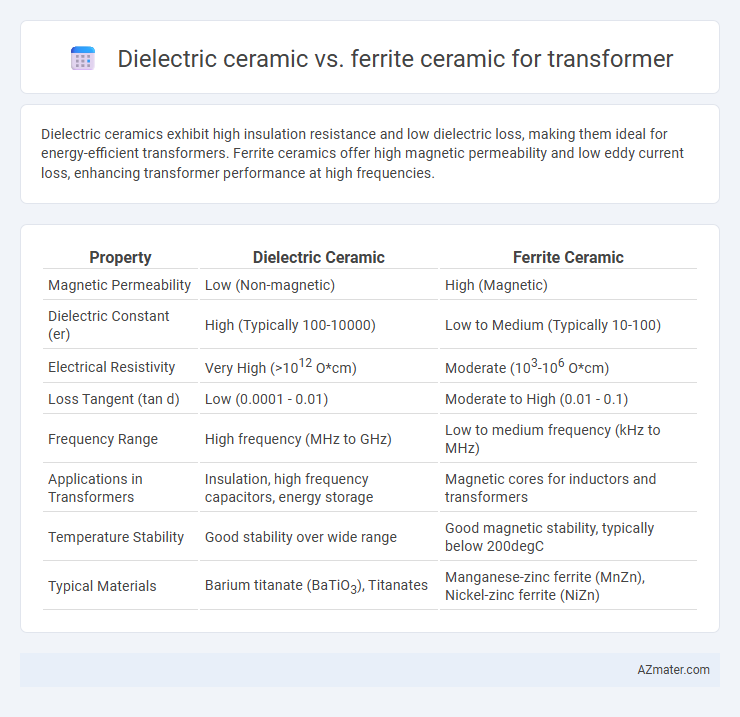Dielectric ceramics exhibit high insulation resistance and low dielectric loss, making them ideal for energy-efficient transformers. Ferrite ceramics offer high magnetic permeability and low eddy current loss, enhancing transformer performance at high frequencies.
Table of Comparison
| Property | Dielectric Ceramic | Ferrite Ceramic |
|---|---|---|
| Magnetic Permeability | Low (Non-magnetic) | High (Magnetic) |
| Dielectric Constant (er) | High (Typically 100-10000) | Low to Medium (Typically 10-100) |
| Electrical Resistivity | Very High (>1012 O*cm) | Moderate (103-106 O*cm) |
| Loss Tangent (tan d) | Low (0.0001 - 0.01) | Moderate to High (0.01 - 0.1) |
| Frequency Range | High frequency (MHz to GHz) | Low to medium frequency (kHz to MHz) |
| Applications in Transformers | Insulation, high frequency capacitors, energy storage | Magnetic cores for inductors and transformers |
| Temperature Stability | Good stability over wide range | Good magnetic stability, typically below 200degC |
| Typical Materials | Barium titanate (BaTiO3), Titanates | Manganese-zinc ferrite (MnZn), Nickel-zinc ferrite (NiZn) |
Introduction to Dielectric and Ferrite Ceramics
Dielectric ceramics exhibit high electrical insulation and low dielectric loss, making them ideal for transformer insulation and energy storage applications. Ferrite ceramics possess magnetic properties due to iron oxide combined with metallic elements, providing high permeability and low eddy current loss crucial for transformer cores. Understanding the distinct electrical and magnetic characteristics of dielectric and ferrite ceramics enables optimized transformer design for improved efficiency and performance.
Material Composition: Dielectric vs Ferrite Ceramics
Dielectric ceramics for transformers primarily consist of non-conductive oxides such as titanium dioxide, barium titanate, or lead zirconate titanate, known for their high dielectric constant and low dielectric loss, which enhances energy efficiency and voltage insulation. Ferrite ceramics are composed of mixed metal oxides like iron oxide (Fe2O3) combined with metals such as manganese, zinc, or nickel, providing high magnetic permeability and low electrical conductivity crucial for minimizing core losses in transformer operation. The material composition distinctly affects magnetic and dielectric properties, making dielectric ceramics ideal for insulation and energy storage, while ferrite ceramics optimize magnetic flux handling and reduce eddy current losses in transformer cores.
Electrical Properties Comparison
Dielectric ceramic exhibits higher dielectric constant and lower loss tangent compared to ferrite ceramic, making it ideal for capacitive applications in transformers where minimal energy dissipation is crucial. Ferrite ceramic, characterized by its high magnetic permeability and low electrical conductivity, excels in magnetic core components, enhancing inductance and reducing eddy current losses. The superior resistivity and stable dielectric properties of dielectric ceramics contrast with the magnetic hysteresis and frequency-dependent permeability found in ferrite ceramics, influencing their distinct roles in transformer efficiency and performance.
Magnetic Characteristics of Ferrite vs Dielectric Ceramics
Ferrite ceramics exhibit high magnetic permeability and low electrical conductivity, enabling efficient magnetic flux conduction and reduced eddy current losses in transformers. Dielectric ceramics, in contrast, possess high electrical resistivity and low magnetic permeability, making them unsuitable for magnetic flux applications but ideal for insulation purposes. The superior magnetic characteristics of ferrite ceramics significantly enhance transformer performance by improving core efficiency and reducing energy losses.
Thermal Stability and Performance
Dielectric ceramics exhibit superior thermal stability in transformer applications due to their low dielectric loss and resistance to temperature-induced property changes, ensuring consistent performance under high thermal stress. Ferrite ceramics offer excellent magnetic permeability but tend to have higher temperature coefficients, which can lead to performance variations and decreased efficiency at elevated temperatures. Selecting dielectric ceramics enhances transformer reliability and efficiency by minimizing thermal degradation and maintaining stable electrical characteristics over a broad temperature range.
Dielectric Losses in Transformer Applications
Dielectric ceramic materials exhibit significantly lower dielectric losses compared to ferrite ceramics, making them more efficient for transformer applications where minimizing energy dissipation is critical. Dielectric ceramics maintain high insulation resistance and reduce eddy current losses due to their non-magnetic properties, enhancing overall transformer performance. Ferrite ceramics, while useful for their magnetic permeability, typically have higher dielectric losses under high-frequency operation, limiting their efficiency in precision transformer designs.
Frequency Response: Which Ceramic is Superior?
Dielectric ceramics exhibit superior frequency response for transformer applications due to their higher dielectric constant and lower loss tangent, enabling efficient operation at high frequencies above 1 MHz. Ferrite ceramics, while excellent for magnetic properties and low power loss in the 50 kHz to 1 MHz range, suffer from increased core losses and reduced efficiency at higher frequencies. Therefore, dielectric ceramics outperform ferrite ceramics in high-frequency transformer designs by maintaining signal integrity and minimizing energy dissipation.
Cost and Manufacturing Considerations
Dielectric ceramics generally incur higher material costs compared to ferrite ceramics due to their complex compositions and precise manufacturing requirements. Ferrite ceramics offer cost-effective production benefits, including lower sintering temperatures and simpler fabrication processes, leading to reduced energy consumption and manufacturing time. Selecting ferrite ceramics for transformers often aligns with budget constraints and mass production scalability, while dielectric ceramics suit specialized applications demanding superior electrical properties despite their higher cost.
Applications of Dielectric and Ferrite Ceramics in Transformers
Dielectric ceramics in transformers are primarily used for insulation and capacitance, enhancing energy storage and minimizing dielectric losses in high-frequency applications. Ferrite ceramics serve as magnetic cores in transformers, improving magnetic permeability and reducing core losses, which results in higher efficiency and compact transformer designs. These distinct properties make dielectric ceramics ideal for high-voltage electrical insulation, while ferrite ceramics are essential for efficient magnetic flux conduction in power and signal transformers.
Conclusion: Choosing the Right Ceramic for Transformers
Dielectric ceramic offers superior insulation properties and high dielectric strength, making it ideal for high-frequency transformers requiring minimal energy loss. Ferrite ceramic, with its magnetic permeability and low eddy current losses, is preferred for transformers in power electronics and RF applications. Selecting the right ceramic depends on balancing insulation needs and magnetic performance to optimize transformer efficiency and reliability.

Infographic: Dielectric ceramic vs Ferrite ceramic for Transformer
 azmater.com
azmater.com